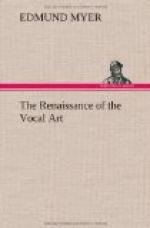That tone is the result of certain conditions demanded by Nature, and that these conditions are dependent upon form and adjustment, cannot be denied; but unless form and adjustment give freedom to the voice, unless they result in the removal of all restraint, then the manner or method in which they are secured must surely be wrong. Local effort or contraction cannot do this. Relaxation cannot secure the true conditions. There is and can be but one principle which makes true form and adjustment possible: All form and adjustment must be automatic, and not the result of direct or local effort.
This brings us to a study of devices; and devices, to influence correctly not only the voice but the individual, must be in accordance with natural and not artificial conditions. The singer must put himself and keep himself upon a level with the tone—upon a level with the tone physically, mentally and emotionally. The device which we use, or the formula, is, lift, expand, and let go.
With the singer who contracts the throat muscles during the act of singing, that which may be called the center of gravity or of effort is at the throat. With the singer who carries a consciously high chest and a drawn-in or contracted diaphragm, the center of gravity is at the chest. With the singer who takes a conscious full breath, and hardens and sets the diaphragm to hold it, the center of gravity is at the diaphragm. In none of these cases is it possible to remove all restraint; for they all result in contraction, especially of the throat muscles, and make flexible expansion—a condition necessary to absolute freedom—impossible.
Place the center of gravity, by thought and action, at the hips. Everything above the hips must be free, flexible, elastic and vitalized when singing. We say, lift, expand, and let go, which must be in the following proportion: Lift a little, expand more than you lift, and let go entirely. The lift is from the hips up, and must be done in a free, flexible manner, with a constant study to make the body lighter and lighter, and the movement more elastic and flexible. Do not lift as though lifting a weight, but lift lightly as though in response to thought or suggestion.
Expand the entire body in a flexible, elastic manner. This will bring into action every muscle of the body, and apply strength and support to the voice; for, as we have found, there is no strength correctly applied except through right movement. When we lift and expand properly, we expand the body as a whole, and not the chest alone, nor the diaphragm, nor the sides. These all come into action and expand with proper movement; but there must be no conscious thought of, nor conscious local effort of, any particular part of the body. When we lift and expand properly the chest becomes active, the diaphragm goes into a singing position, and every muscle of the body is on the alert and ready to respond to the thought or desire of the singer. Not only this; when we lift and expand properly, we influence directly the form and adjustment of all the vocal muscles, and especially the organ of sound itself. In this way the voice is actually and artistically tuned for the production of correct tone, as is the violin in the hands of the master before playing.




